Workers in Canada are entitled to a diverse range of human rights in the workplace. Yet many times those rights have been denied. Workers have organized to protect and uphold their rights, creating positive change in the process.
The exhibit Rights on the Job tells the story of three important human rights struggles undertaken by workers in their respective workplaces. It also underlines the importance of solidarity among workers.




